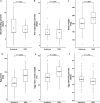Subolesin vaccination inhibits blood feeding and reproduction of Haemaphysalis longicornis in rabbits
- PMID: 32948229
- PMCID: PMC7501621
- DOI: 10.1186/s13071-020-04359-w
Subolesin vaccination inhibits blood feeding and reproduction of Haemaphysalis longicornis in rabbits
Abstract
Background: Ticks can transmit numerous tick-borne pathogens and cause a huge economic loss to the livestock industry. Tick vaccines can contribute to the prevention of tick-borne diseases by inhibiting tick infestation or reproduction. Subolesin is an antigenic molecule proven to be a potential tick vaccine against different tick species and even some tick-borne pathogens. However, its effectivity has not been verified in Haemaphysalis longicornis, which is a widely distributed tick species, especially in East Asian countries. Therefore, the purpose of this study was to evaluate the effectivity of subolesin vaccination against H. longicornis in a rabbit model.
Methods: Haemaphysalis longicornis (Okayama strain, female, adult, parthenogenetic strain) and Japanese white rabbits were used as the model tick and animal, respectively. The whole open reading frame of H. longicornis subolesin (HlSu) was identified and expressed as a recombinant protein using E. coli. The expression was verified using sodium dodecyl sulfate polyacrylamide gel electrophoresis, and the immunogenicity of rHlSu against anti-H. longicornis rabbit serum was confirmed using Western blotting. After vaccination of rHlSu in rabbits, experimental infestation of H. longicornis was performed. Variables related to blood-feeding periods, pre-oviposition periods, body weight at engorgement, egg mass, egg mass to body weight ratio, and egg-hatching periods were measured to evaluate the effectiveness of subolesin vaccination.
Results: The whole open reading frame of HlSu was 540 bp, and it was expressed as a recombinant protein. Vaccination with rHlSu stimulated an immune response in rabbits. In the rHlSu-vaccinated group, body weight at engorgement, egg mass, and egg mass to body weight ratio were statistically significantly lower than those in the control group. Besides, egg-hatching periods were extended significantly. Blood-feeding periods and pre-oviposition periods were not different between the two groups. In total, the calculated vaccine efficacy was 37.4%.
Conclusions: Vaccination of rabbits with rHlSu significantly affected the blood-feeding and reproduction in H. longicornis. Combined with findings from previous studies, our findings suggest subolesin has the potential to be used as a universal tick vaccine.
Keywords: Akirin; Haemaphysalis longicornis; Subolesin; Tick; Tick-borne disease; Vaccine.
Conflict of interest statement
The authors declare that they have no competing interests.
Figures




Similar articles
-
Effect of Silencing subolesin and enolase impairs gene expression, engorgement and reproduction in Haemaphysalis longicornis (Acari: Ixodidae) ticks.J Vet Sci. 2024 May;25(3):e43. doi: 10.4142/jvs.24039. J Vet Sci. 2024. PMID: 38834512 Free PMC article.
-
Hemalin vaccination modulates the host immune response and reproductive cycle of Haemaphysalis longicornis.Vet Parasitol. 2023 Nov;323:110051. doi: 10.1016/j.vetpar.2023.110051. Epub 2023 Oct 10. Vet Parasitol. 2023. PMID: 37866015
-
Comprehensive antigen identification and comparative analysis: significant approaches for controlling Haemaphysalis longicornis ticks.J Vet Sci. 2025 Mar;26(2):e16. doi: 10.4142/jvs.24250. J Vet Sci. 2025. PMID: 40183904 Free PMC article. Review.
-
Cross protection induced by combined Subolesin-based DNA and protein immunizations against adult Haemaphysalis longicornis.Vaccine. 2020 Jan 22;38(4):907-915. doi: 10.1016/j.vaccine.2019.10.076. Epub 2019 Nov 4. Vaccine. 2020. PMID: 31699505
-
Targeting arthropod subolesin/akirin for the development of a universal vaccine for control of vector infestations and pathogen transmission.Vet Parasitol. 2011 Sep 8;181(1):17-22. doi: 10.1016/j.vetpar.2011.04.018. Epub 2011 Apr 19. Vet Parasitol. 2011. PMID: 21561715 Review.
Cited by
-
Haemaphysalis longicornis subolesin controls the infection and transmission of severe fever with thrombocytopenia syndrome virus.NPJ Vaccines. 2025 Jan 24;10(1):17. doi: 10.1038/s41541-024-01061-1. NPJ Vaccines. 2025. PMID: 39856151 Free PMC article.
-
Evolution of tick vaccinology.Parasitology. 2024 Aug;151(9):1045-1052. doi: 10.1017/S003118202400043X. Epub 2024 Apr 8. Parasitology. 2024. PMID: 38586999 Free PMC article. Review.
-
Approaches to Integrated Parasite Management (IPM) for Theileria orientalis with an Emphasis on Immunity.Pathogens. 2021 Sep 7;10(9):1153. doi: 10.3390/pathogens10091153. Pathogens. 2021. PMID: 34578185 Free PMC article. Review.
-
Effect of Silencing subolesin and enolase impairs gene expression, engorgement and reproduction in Haemaphysalis longicornis (Acari: Ixodidae) ticks.J Vet Sci. 2024 May;25(3):e43. doi: 10.4142/jvs.24039. J Vet Sci. 2024. PMID: 38834512 Free PMC article.
-
Molecular characterization and immune efficacy of fructose-1,6-bisphosphate aldolase from Haemaphysalis longicornis (Acari: Ixodidae).Parasit Vectors. 2023 May 25;16(1):169. doi: 10.1186/s13071-023-05794-1. Parasit Vectors. 2023. PMID: 37231514 Free PMC article.
References
MeSH terms
Substances
Grants and funding
LinkOut - more resources
Full Text Sources
Medical

